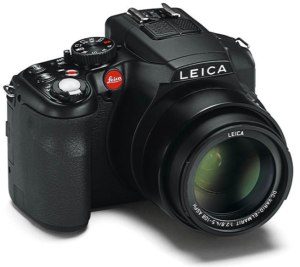Camera News
Superzooms and the Resolution Scam
Evan Powell — February 5, 2014
The superzoom "bridge" camera is one of my all-time favorite camera designs. Nothing beats the superzoom for light weight, convenience, and maximum flexibility to compose the image you want. It's not for everything--it's no good for studio work, you wouldn't use it for professional portrait, wedding or fashion photography, and if you're shooting an NFL game for Sports Illustrated you need a fast high-res DSLR. But for the fine art street photographer or travelers who want to travel light but want to capture an African safari or the mountains and ruins of Machu Picchu, the advanced superzoom is it.
Anything you would have used a 35mm film camera for back in the day, today's advanced superzooms do better. But there are superzooms, and there are superzooms. The digital world offers dozens of models on a continuous trade-off between small size/convenience on the one hand and bigger/better performance on the other. And bigger/better always comes with a higher price tag. For people serious about photography, the difference is worth it.
 How do you choose the right superzoom camera for you, assuming a superzoom is what you need? First, it is vital to ignore megapixels. Despite the fact that writers have been beating this drum for a long time, many people still equate more megapixels (MP) with higher resolution and a sharper picture. Not so. Leica and Panasonic offer 12 MP superzoom cameras that can take many of the 16MP and 18 MP competitors to the cleaners as far as image sharpness and clarity is concerned. In this class of camera, megapixels is nothing more than a marketing gimmick. Why? Because the physics of a very long optical zoom lens requires the sensor size to be VERY small. Most superzoom cameras have sensors that are about 1/30 the size of a full frame 35 mm sensor, about the surface area of a pencil eraser.
How do you choose the right superzoom camera for you, assuming a superzoom is what you need? First, it is vital to ignore megapixels. Despite the fact that writers have been beating this drum for a long time, many people still equate more megapixels (MP) with higher resolution and a sharper picture. Not so. Leica and Panasonic offer 12 MP superzoom cameras that can take many of the 16MP and 18 MP competitors to the cleaners as far as image sharpness and clarity is concerned. In this class of camera, megapixels is nothing more than a marketing gimmick. Why? Because the physics of a very long optical zoom lens requires the sensor size to be VERY small. Most superzoom cameras have sensors that are about 1/30 the size of a full frame 35 mm sensor, about the surface area of a pencil eraser.
With sensors that tiny there are only so many pixels that can be jammed onto them and still have them be efficient. From the results we've seen, 16 or 18 million is too many. But since consumers often get suckered into thinking more is better, competing camera makers have settled on 16MP to 18MP as the spec sweetspot for marketing purposes. It is hard for the consumer to understand that a 12MP camera may actually produce sharper, cleaner, lower noise images that a 16MP camera, but that is in fact the case. Leica's current V-Lux 4 uses a 12 MP sensor. Leica doesn't do that to save money or make a cheaper product or because they are behind the technology curve. They use the 12MP sensor because it makes better pictures (at least at the current state of the art).
Leica isn't the only one who has figured this out. Canon has just released several new upscale pocket models including the G16, the N100 and the S120. These are priced in the $350 to $460 range, they all have sensors about 25% larger than those in the superzooms, but they are all 12MP resolution. This is a refreshing indicator that Canon, at least, thinks consumers are getting wise to the resolution scam.
This is the first of several postings on superzoom cameras. Next up will be comments on the importance of the fully articulating screens and viewfinders in helping you find the best compositions. And, as long as we just brought up Leica, many want to know whether there really is any difference between the Leica and Panasonic brands of superzooms? Everyone knows that these two companies are in partnership and that they market superzoom cameras under each of their labels that look almost identical. But are they? We shall see.
Evan Powell
Editor
.
Anything you would have used a 35mm film camera for back in the day, today's advanced superzooms do better. But there are superzooms, and there are superzooms. The digital world offers dozens of models on a continuous trade-off between small size/convenience on the one hand and bigger/better performance on the other. And bigger/better always comes with a higher price tag. For people serious about photography, the difference is worth it.
 How do you choose the right superzoom camera for you, assuming a superzoom is what you need? First, it is vital to ignore megapixels. Despite the fact that writers have been beating this drum for a long time, many people still equate more megapixels (MP) with higher resolution and a sharper picture. Not so. Leica and Panasonic offer 12 MP superzoom cameras that can take many of the 16MP and 18 MP competitors to the cleaners as far as image sharpness and clarity is concerned. In this class of camera, megapixels is nothing more than a marketing gimmick. Why? Because the physics of a very long optical zoom lens requires the sensor size to be VERY small. Most superzoom cameras have sensors that are about 1/30 the size of a full frame 35 mm sensor, about the surface area of a pencil eraser.
How do you choose the right superzoom camera for you, assuming a superzoom is what you need? First, it is vital to ignore megapixels. Despite the fact that writers have been beating this drum for a long time, many people still equate more megapixels (MP) with higher resolution and a sharper picture. Not so. Leica and Panasonic offer 12 MP superzoom cameras that can take many of the 16MP and 18 MP competitors to the cleaners as far as image sharpness and clarity is concerned. In this class of camera, megapixels is nothing more than a marketing gimmick. Why? Because the physics of a very long optical zoom lens requires the sensor size to be VERY small. Most superzoom cameras have sensors that are about 1/30 the size of a full frame 35 mm sensor, about the surface area of a pencil eraser.With sensors that tiny there are only so many pixels that can be jammed onto them and still have them be efficient. From the results we've seen, 16 or 18 million is too many. But since consumers often get suckered into thinking more is better, competing camera makers have settled on 16MP to 18MP as the spec sweetspot for marketing purposes. It is hard for the consumer to understand that a 12MP camera may actually produce sharper, cleaner, lower noise images that a 16MP camera, but that is in fact the case. Leica's current V-Lux 4 uses a 12 MP sensor. Leica doesn't do that to save money or make a cheaper product or because they are behind the technology curve. They use the 12MP sensor because it makes better pictures (at least at the current state of the art).
Leica isn't the only one who has figured this out. Canon has just released several new upscale pocket models including the G16, the N100 and the S120. These are priced in the $350 to $460 range, they all have sensors about 25% larger than those in the superzooms, but they are all 12MP resolution. This is a refreshing indicator that Canon, at least, thinks consumers are getting wise to the resolution scam.
This is the first of several postings on superzoom cameras. Next up will be comments on the importance of the fully articulating screens and viewfinders in helping you find the best compositions. And, as long as we just brought up Leica, many want to know whether there really is any difference between the Leica and Panasonic brands of superzooms? Everyone knows that these two companies are in partnership and that they market superzoom cameras under each of their labels that look almost identical. But are they? We shall see.
Evan Powell
Editor
.
Comments (2)
Reader Comments(2 comments)
|
Posted Apr 8, 2014 10:13:05 AM
|
|
By Evan Powell, Editor |
Post a Comment |
George, thanks for the good question. In our experience there is a trade-off between extreme zoom convenience and picture quality. Today's superzooms go up to 1000mm equivalent, but the downside is that lens quality and image stabilization is compromised to some degree. Panasonic and Leica have (so far) limited their superzoom range on the FZ200 and V-Lux 4 to 600mm, and handheld results at maximum zoom on these cameras are exceptionally good. The one exception is the Sony HX300, which does have solid sharpness at a very long max zoom range. It is a good option if you don't need or want to capture RAW files, as the HX300 does not have that capability.
|
Posted Apr 2, 2014 4:41:01 PM
|
|
By George |
Post a Comment |
Is it important for these super zoom cameras to have OIS in order to get IQ? I am wanting to buy a digicam with a super zoom and shooting without a tripod. How much zoom should be the maximum to achieve high IQ? I would sincerely appreciate your answer.
Post a comment
Commenting on this article is easy and does not require any registration. Your email address is necessary for you to activate your comment once it has been submitted. It will not be shown to other site viewers. 2 Camera Guys reserves the right to remove any comment at any time for any reason. Foul language is not permitted, nor are personal attacks. All comments should remain on topic.









